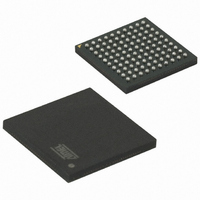ATSAM3U4CA-CU Atmel, ATSAM3U4CA-CU Datasheet - Page 1017

ATSAM3U4CA-CU
Manufacturer Part Number
ATSAM3U4CA-CU
Description
IC MCU 32BIT 256KB FLSH 100TFBGA
Manufacturer
Atmel
Series
SAM3Ur
Specifications of ATSAM3U4CA-CU
Core Processor
ARM® Cortex-M3™
Core Size
32-Bit
Speed
96MHz
Connectivity
EBI/EMI, I²C, MMC, SPI, SSC, UART/USART, USB
Peripherals
Brown-out Detect/Reset, DMA, I²S, POR, PWM, WDT
Number Of I /o
57
Program Memory Size
256KB (256K x 8)
Program Memory Type
FLASH
Ram Size
52K x 8
Voltage - Supply (vcc/vdd)
1.65 V ~ 1.95 V
Data Converters
A/D 4x10b, 4x12b
Oscillator Type
Internal
Operating Temperature
-40°C ~ 85°C
Package / Case
100-TFBGA
Processor Series
ATSAM3x
Core
ARM Cortex M3
Data Bus Width
32 bit
Data Ram Size
52 KB
Interface Type
3xUSART, TWI, 4xSPI, Bus
Maximum Clock Frequency
96 MHz
Number Of Programmable I/os
57
Number Of Timers
8
Operating Supply Voltage
1.62 V to 3.6 V
Maximum Operating Temperature
+ 85 C
Mounting Style
SMD/SMT
3rd Party Development Tools
JTRACE-CM3, MDK-ARM, RL-ARM, ULINK2
Development Tools By Supplier
ATSAM3U-EK
Minimum Operating Temperature
- 40 C
Lead Free Status / RoHS Status
Lead free / RoHS Compliant
Eeprom Size
-
Lead Free Status / Rohs Status
Lead free / RoHS Compliant
Available stocks
Company
Part Number
Manufacturer
Quantity
Price
Part Number:
ATSAM3U4CA-CU
Manufacturer:
ATMEL/爱特梅尔
Quantity:
20 000
- Current page: 1017 of 1171
- Download datasheet (25Mb)
40.3.2
40.3.3
40.3.3.1
40.3.3.2
6430D–ATARM–25-Mar-11
Memory Peripherals
Handshaking Interface
Software Handshaking
Chunk Transactions
Bus locking: Software can program a channel to maintain control of the AMBA bus by asserting
hmastlock for the duration of a DMAC transfer, buffer, or transaction (single or chunk). Channel
locking is asserted for the duration of bus locking at a minimum.
Figure 40-3 on page 1015
peripheral. There is no handshaking interface with the DMAC, and therefore the memory periph-
eral can never be a flow controller. Once the channel is enabled, the transfer proceeds
immediately without waiting for a transaction request. The alternative to not having a transac-
tion-level handshaking interface is to allow the DMAC to attempt AMBA transfers to the
peripheral once the channel is enabled. If the peripheral slave cannot accept these AMBA trans-
fers, it inserts wait states onto the bus until it is ready; it is not recommended that more than 16
wait states be inserted onto the bus. By using the handshaking interface, the peripheral can sig-
nal to the DMAC that it is ready to transmit/receive data, and then the DMAC can access the
peripheral without the peripheral inserting wait states onto the bus.
Handshaking interfaces are used at the transaction level to control the flow of single or chunk
transfers. The operation of the handshaking interface is different and depends on whether the
peripheral or the DMAC is the flow controller.
The peripheral uses the handshaking interface to indicate to the DMAC that it is ready to trans-
fer/accept data over the AMBA bus. A non-memory peripheral can request a DMAC transfer
through the DMAC using one of two handshaking interfaces:
Software selects between the hardware or software handshaking interface on a per-channel
basis. Software handshaking is accomplished through memory-mapped registers, while hard-
ware handshaking is accomplished using a dedicated handshaking interface.
When the slave peripheral requires the DMAC to perform a DMAC transaction, it communicates
this request by sending an interrupt to the CPU or interrupt controller.
The interrupt service routine then uses the software registers to initiate and control a DMAC
transaction. These software registers are used to implement the software handshaking
interface.
The SRC_H2SEL/DST_H2SEL bit in the DMAC_CFGx channel configuration register must be
set to zero to enable software handshaking.
When the peripheral is not the flow controller, then the last transaction register DMAC_LAST is
not used, and the values in these registers are ignored.
Writing a 1 to the DMAC_CREQ[2x] register starts a source chunk transaction request, where x
is the channel number. Writing a 1 to the DMAC_CREQ[2x+1] register starts a destination chunk
transfer request, where x is the channel number.
Upon completion of the chunk transaction, the hardware clears the DMAC_CREQ[2x] or
DMAC_CREQ[2x+1].
• Hardware handshaking
• Software handshaking
shows the DMAC transfer hierarchy of the DMAC for a memory
SAM3U Series
1017
Related parts for ATSAM3U4CA-CU
Image
Part Number
Description
Manufacturer
Datasheet
Request
R

Part Number:
Description:
KIT EVAL FOR AT91SAM3U CORTEX
Manufacturer:
Atmel
Datasheet:

Part Number:
Description:
AT91 ARM Thumb-based Microcontrollers
Manufacturer:
ATMEL [ATMEL Corporation]
Datasheet:

Part Number:
Description:
DEV KIT FOR AVR/AVR32
Manufacturer:
Atmel
Datasheet:

Part Number:
Description:
INTERVAL AND WIPE/WASH WIPER CONTROL IC WITH DELAY
Manufacturer:
ATMEL Corporation
Datasheet:

Part Number:
Description:
Low-Voltage Voice-Switched IC for Hands-Free Operation
Manufacturer:
ATMEL Corporation
Datasheet:

Part Number:
Description:
MONOLITHIC INTEGRATED FEATUREPHONE CIRCUIT
Manufacturer:
ATMEL Corporation
Datasheet:

Part Number:
Description:
AM-FM Receiver IC U4255BM-M
Manufacturer:
ATMEL Corporation
Datasheet:

Part Number:
Description:
Monolithic Integrated Feature Phone Circuit
Manufacturer:
ATMEL Corporation
Datasheet:

Part Number:
Description:
Multistandard Video-IF and Quasi Parallel Sound Processing
Manufacturer:
ATMEL Corporation
Datasheet:

Part Number:
Description:
High-performance EE PLD
Manufacturer:
ATMEL Corporation
Datasheet:

Part Number:
Description:
8-bit Flash Microcontroller
Manufacturer:
ATMEL Corporation
Datasheet:

Part Number:
Description:
2-Wire Serial EEPROM
Manufacturer:
ATMEL Corporation
Datasheet:











